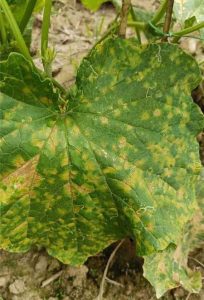Downy mildew is a common fungal disease that affects cucurbits, which include plants such as cucumbers, melons, gourds, pumpkins, and squash. It is caused by the pathogen Pseudoperonospora cubensis. This disease is highly destructive and can cause significant losses in yield if not managed properly.
We’re here to help you out to take necessary preventive measures, identify the signs of pathogen, find the conditions favorable for its growth to avoid it and to act quickly if the symptoms are detected.
Symptoms of Downy Mildew in Cucurbits

- Appearance of small, angular yellow spots on the upper surface of the leaves.
- As the disease progresses, the yellow spots enlarge and turn brown. The lesions typically have angular edges, following the veins of the leaf. The affected areas may become dry and papery.
- During wet season or when the leaves are wet, water-soaked lesions can be seen on the underside of the leaves. Later, these lesions turn into fuzzy gray to purple mold-like fungus growth.
- The entire foliage may show signs of wilting.
- Infected plants may produce fewer fruits, and the ones that do develop may be smaller, misshapen, or have a poor flavor.
- Severe cases of downy mildew can lead to stunted growth of the plants.
Understand the Ideal conditions for Downy mildew development and spread
Downy mildew thrives under cool (15-20°C), wet and humid conditions. It spreads rapidly during periods of high humidity, such as rainy weather or heavy dew. The pathogen requires free moisture on the leaf surface for infection and development.
It can survive in infected plant debris, seeds and soil, but it primarily spreads through airborne spores. These spores can travel long distances on the wind and infect healthy plants. The disease can also be introduced through infected seedlings or transplants.
Preventive Measures for Downy Mildew in Cucurbits
- Ensure to plant healthy seeds and transplants.
- For planting choose varieties that have resistance or tolerance to downy mildew like IRIS hybrid vegetable seeds F1 hybrid cucumber Janki, IRIS cucumber Dawat seeds, Sorot Ridge gourd, MH 38 Muskmelon seeds.
- Practice crop rotation with crops like legumes, tomato, brinjal and root crops for one or two growing seasons to disrupt the disease cycle and reduce the pathogen’s population in the soil.
- Promote good air circulation by adopting wide spacing between plants and pruning dense foliage to allow for better sunlight penetration and quicker leaf drying.
- Avoid overhead irrigation, as it creates leaf wetness favorable for pathogen development. Instead, use drip irrigation or hoses to water at the base of the plants, keeping the foliage dry.
- Remove and destroy any infected plant debris including fallen leaves, infected fruits, and any other plant residues. Properly clean tools and equipment to prevent the spread of the pathogen.
- Spray Neem oil for control of downy mildew.
- Apply protectant fungicide like 1% Bordeaux mixture or other copper-based fungicide or Mancozeb at 5 – 7 days interval as a prophylactic measure to prevent the disease incidence.
Effective Management to Control the Disease
Spray the chemicals at 7 – 14 days interval depending on the disease intensity and weather conditions. Bio-fungicides and some of the chemical fungicides such as Mancozeb and Copper oxychloride mentioned below can also be sprayed before the disease incidence as a preventive measure.
| Product name | Technical content | Dosage |
| Biological Management | ||
| Downy Raze | Botanical extracts | 2.5 ml/lit of water |
| Anand Dr Bacto’s Fluro Bio Fungicide | Pseudomonas fluorescens | 2.5 ml/lit of water
|
| Chemical Management | ||
| Cabrio Top Fungicide | Metiram 55% + Pyraclostrobin 5% WG | 3 gm/lit of water |
| Blitox Fungicide | Copper Oxychloride 50 % WP | 2 gm/lit of water |
| Zampro Fungicide | Ametoctradin 27% + Dimethomorph 20.27% SC | 1.5 ml/lit of water |
| Taqat Fungicide | Hexaconazole 5% + Captan 70% WP | 2 gm/lit of water |
| Ridomil Gold | Metalaxyl 4% + Manconzeb 64% WP | 2 gm/lit of water |
| Propi Fungicide | Propineb 70% WP | 3 gm/lit of water |
| Moximate Fungicide | Cymoxanil 8% + Mancozeb 64% WP | 2 gm/lit of water |
Note:
- Always read and follow the instructions provided on the product label, including application rates, timing and safety precautions.
- Alternate the products for spraying.
- Always prepare Bordeaux mixture fresh and use on the same day.
Discover effective strategies for defeating Gummy Stem Blight in cucurbits. Learn more.





